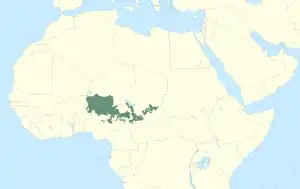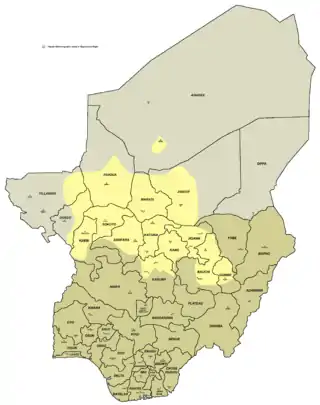| Chadic | |
|---|---|
| Geographic distribution | Nigeria, Niger, Chad, Central African Republic, Cameroon |
| Linguistic classification | Afro-Asiatic
|
| Subdivisions | |
| ISO 639-5 | cdc |
| Glottolog | chad1250 |
 Map of the distribution of the Chadic languages within Africa | |
 Detailed map of the distribution of Chadic languages in Western and Central Africa | |
The Chadic languages form a branch of the Afroasiatic language family. They are spoken in parts of the Sahel. They include 150 languages spoken across northern Nigeria, southern Niger, southern Chad, the Central African Republic, and northern Cameroon. By far the most widely spoken Chadic language is Hausa, a lingua franca of much of inland Eastern West Africa, particularly Niger and the northern half of Nigeria.
Composition
Paul Newman (1977) classified the languages into the four groups which have been accepted in all subsequent literature. Further subbranching, however, has not been as robust; Roger Blench (2006), for example, only accepts the A/B bifurcation of East Chadic.[1] Kujargé has been added from Blench (2008), who suggests Kujargé may have split off before the breakup of Proto-Chadic and then subsequently became influenced by East Chadic.[2] Subsequent work by Joseph Lovestrand argues strongly that Kujarge is a valid member of East Chadic. The placing of Luri as a primary split of West Chadic is erroneous. Bernard Caron (2004) shows that this language is South Bauchi and part of the Polci cluster.
- West Chadic. Two branches, which include
- (A) the Hausa, Ron, Bole, and Angas languages; and
- (B) the Bade, Warji, and Zaar languages.
- Biu–Mandara (Central Chadic). Three branches, which include
- (A) the Bura, Kamwe, and Bata languages, among other groups;
- (B) the Buduma and Musgu languages; and
- (C) Gidar
- East Chadic. Two branches, which include

Origin


Modern genetic studies of Northwestern Cameroonian Chadic-speaking populations have observed high frequencies of the Y-chromosome Haplogroup R1b in these populations (the R1b-V88[3] variant). This paternal marker is common in parts of West Eurasia, but otherwise rare in Africa. Cruciani et al. (2010) thus proposed that the Proto-Chadic speakers during the mid-Holocene (~7,000 years ago) migrated from the Levant to the Central Sahara, and from there settled in the Lake Chad Basin.[4]
D'Atanasio et al. (2018) claim that R1b-V88 originated in Europe about 12,000 years ago and crossed to North Africa by about 8000 years ago; it may formerly have been common in southern Europe, where it has since been replaced by waves of other haplogroups, leaving remnant subclades almost exclusively in Sardinia. It first radiated within Africa likely between 7 and 8 000 years ago – at the same time as trans-Saharan expansions within the unrelated haplogroups E-M2 and A-M13 – possibly due to population growth allowed by humid conditions and the adoption of livestock herding in the Sahara. R1b-V1589, the main subclade within R1b-V88, underwent a further expansion around 5500 years ago, likely in the Lake Chad Basin region, from which some lines recrossed the Sahara to North Africa.[5][6]
Loanwords
Chadic languages contain many Nilo-Saharan loanwords from either the Songhay or Maban branches, pointing to early contact between Chadic and Nilo-Saharan speakers as Chadic was migrating west.[7]
Although Adamawa languages are spoken adjacently to Chadic languages, interaction between Chadic and Adamawa is limited.[8]
Pronouns
Pronouns in Proto-Chadic, as compared to pronouns in Proto-Afroasiatic (Vossen & Dimmendaal 2020:351):[9]
| Pronoun | Proto-Chadic | Proto-Afroasiatic |
|---|---|---|
| 1 | *ní | *i ~ *yi |
| 2M | *ka | *ku, *ka |
| 2F | *ki(m) | *kim |
| 3M | *nì | *si, *isi |
| 3F | *ta | |
| 1PL | *mun (incl.), *na (excl.) | (*-na ~ *-nu ~ *-ni) ? |
| 2PL | *kun | *kuuna |
| 3PL | *sun | *su ~ *usu |
Comparative vocabulary
Sample basic vocabulary in different Chadic branches listed in order from west to east, with reconstructions of other Afroasiatic branches also given for comparison:
| Language | eye | ear | nose | tooth | tongue | mouth | blood | bone | tree | water | eat | name |
|---|---|---|---|---|---|---|---|---|---|---|---|---|
| Proto-Chadic[10] | *ydn | *km/*ɬm | *ntn | *s₃n; *ƙ-d | *ls₃- | *bk | *br | *ƙs₃ | *ymn | *hrɗ (hard); *twy (soft) | *s₃m | |
| Hausa[11] | ido | kunne | hanci | haƙori | harshe | baki | jini | ƙashi | itaci; bishiya | ruwa | ci | suna |
| Proto-Ron[12] | *kumu | **atin | *haŋgor | *liʃ | *fo | ɟɑ̄lɑ̄, tɾɔ̃̄ | *kaʃ | *sum | ||||
| Proto-South Bauchi[13] | *(gwà)yìr(-ŋ) | *kə̂m(-si) | *bʸak(-ì) | *bìràm | *gu(ŋ)ul | *pit-ə̀ | *(yì)sûm(-s₃) | |||||
| Polci[14] | yiir | kəəm | cin | shen | haƙori | bii | buran; bəran | gooloo | pət | maa | ci | suŋ |
| Proto-Central Chadic[15] | *hadaj; *tsɨʸ | *ɬɨmɨɗʸ | *hʷɨtsɨnʸ | *ɬɨɗɨnʸ | *ɗɨrɨnɨhʸ; *ɣanaɗʸ; *naɬɨj | *maj | *ɗiɬ; *kɨrakaɬʸ | *hʷɨp | *ɗɨjɨm | *zɨm | *ɬɨmɨɗʸ | |
| Proto-Masa[16] | *ir | *hum | *cin | *s- | *si | *vun | *vuzur | *sok | *gu | *mb- | *ti | *sem |
| Kujarge[17] | kunɟu | kumayo ~ kime | kaata | kiya | aliŋati | apa | ɪbɪrí | (kaɟeɟa), kàyɛ́ya | kaʃíè | ʃia | (tona), tuye [imp. sg.]; tuwona [imp. pl.] | rúwà |
| Other Afroasiatic branches | ||||||||||||
| Proto-Cushitic[18] | *ʔil- | *ʔisŋʷ- | *ʔiɬkʷ- | *caanrab- | *ʔaf-/*yaf- | *mikʷ’-; *moc’- | *-aħm-/*-uħm-; *ɬaam- | *sim-/*sum- | ||||
| Proto-Maji[19] | *ʔaːb | *háːy | *aːç’u | *eːdu | *uːs | *inču | *haːy | *um | ||||
| Tarifiyt Berber[20] | ŧit’t’ | aməžžun, aməz’z’uɣ | ŧinzā | ŧiɣməsŧ | iřəs | aqəmmum | iđammən | iɣəss | aman | šš | isəm | |
| Coptic | ia | ma'aje | ša | šol, najhe | las | ro | snof | kas | šēn | mou | wōm | ran |
| Proto-Semitic[21] | *ʕayn- | *ʔuḏn- | *ʔanp- | *šinn- | *lišān- | *dam- | *ʕaṯ̣m- | *ʕiṣ̂- | *mā̆y- | *ʔ-k-l | (*šim-) | |
| Proto-Afroasiatic[22] | *ʔǐl- | *-ʔânxʷ- | *sǐn-/*sǎn- 'tip, point' | *-lis’- 'to lick' | *âf- | *dîm-/*dâm- | *k’os- | *ɣǎ | *âm-; *akʷ’- | *-mǎaʕ-; *-iit-; *-kʷ’-̌ | *sǔm-/*sǐm- | |
Bibliography
- Caron, Bernard 2004. Le Luri: quelques notes sur une langue tchadique du Nigeria. In: Pascal Boyeldieu & Pierre Nougayrol (eds.), Langues et Cultures: Terrains d’Afrique. Hommages à France Cloarec-Heiss (Afrique et Langage 7). 193–201. Louvain-Paris: Peeters.
- Lukas, Johannes (1936) 'The linguistic situation in the Lake Chad area in Central Africa.' Africa, 9, 332–349.
- Lukas, Johannes. Zentralsudanische Studien, Hamburg 1937;
- Newman, Paul; Ma, Roxana (1966). "Comparative Chadic: Phonology and lexicon". Journal of African Languages. 5: 218–251. hdl:2022/21342.
- Newman, Paul (1977) 'Chadic classification and reconstructions.' Afroasiatic Linguistics 5, 1, 1–42.
- Newman, Paul (1978) 'Chado-Hamitic 'adieu': new thoughts on Chadic language classification', in Fronzaroli, Pelio (ed.), Atti del Secondo Congresso Internazionale di Linguistica Camito-Semitica. Florence: Instituto de Linguistica e di Lingue Orientali, Università di Firenze, 389–397.
- Newman, Paul (1980) The Classification of Chadic within Afroasiatic. Leiden: Universitaire Pers Leiden.
- Herrmann Jungraithmayr, Kiyoshi Shimizu: Chadic lexical roots. Reimer, Berlin 1981.
- Herrmann Jungraithmayr, Dymitr Ibriszimow: Chadic lexical roots. 2 volumes. Reimer, Berlin 1994
- Schuh, Russell (2003) 'Chadic overview', in M. Lionel Bender, Gabor Takacs, and David L. Appleyard (eds.), Selected Comparative-Historical Afrasian Linguistic Studies in Memory of Igor M. Diakonoff, LINCOM Europa, 55–60.
- Data sets
- Kraft, Charles H. (1981). "CLDF:Wordlist". CLDF dataset derived from Kraft's "Chadic Wordlists" from 1981. Geneva. doi:10.5281/zenodo.3534953.
{{cite book}}: CS1 maint: location missing publisher (link)
See also
- Proto-Chadic reconstructions (Wiktionary)
References
- ↑ Blench, 2006. The Afro-Asiatic Languages: Classification and Reference List (ms)
- ↑ Blench, Roger. 2008. Links between Cushitic, Omotic, Chadic and the position of Kujarge. 5th International Conference of Cushitic and Omotic languages.
- ↑ "R-Y7771 YTree".
- ↑ Cruciani, F; Trombetta, B; Sellitto, D; Massaia, A; Destro-Bisol, G; Watson, E; Beraud Colomb, E; Dugoujon, JM; Moral, P; Scozzari, R (2010). "Human Y chromosome haplogroup R-V88: a paternal genetic record of early mid Holocene trans-Saharan connections and the spread of Chadic languages". European Journal of Human Genetics. 18 (7): 800–7. doi:10.1038/ejhg.2009.231. PMC 2987365. PMID 20051990.
- ↑ D’Atanasio, Eugenia; Trombetta, Beniamino; Bonito, Maria; Finocchio, Andrea; Di Vito, Genny; Seghizzi, Mara; Romano, Rita; Russo, Gianluca; Paganotti, Giacomo Maria; Watson, Elizabeth; Coppa, Alfredo; Anagnostou, Paolo; Dugoujon, Jean-Michel; Moral, Pedro; Sellitto, Daniele; Novelletto, Andrea; Cruciani, Fulvio (December 2018). "The peopling of the last Green Sahara revealed by high-coverage resequencing of trans-Saharan patrilineages". Genome Biology. 19 (1): 20. doi:10.1186/s13059-018-1393-5. PMC 5809971. PMID 29433568.
- ↑ Xue, Yali (December 2018). "A history of male migration in and out of the Green Sahara". Genome Biology. 19 (1): 30. doi:10.1186/s13059-018-1410-8. PMC 5851091. PMID 29534762.
- ↑ Ehret, Christopher (5 December 2006). "The Nilo-Saharan background of Chadic". Studies in African Linguistics. 35: 56–66. doi:10.32473/sal.v35i0.107316. S2CID 195404449.
- ↑ Blench, Roger. 2012. Linguistic evidence for the chronological stratification of populations South of Lake Chad. Presentation for Mega-Tchad Colloquium in Naples, September 13–15, 2012.
- ↑ Vossen, Rainer and Gerrit J. Dimmendaal (eds.). 2020. The Oxford Handbook of African Languages. Oxford: Oxford University Press.
- ↑ Jungraithmayr, Herrmann; Ibriszimow, Dymitr (1994). Chadic Lexical Roots: Tentative reconstruction, grading, distribution and comments. (Sprache und Oralität in Afrika; 20), volume I, Berlin: Dietrich Reimer Verlag.
- ↑ Cosper, Ronald. 2015. Hausa dictionary. In: Key, Mary Ritchie & Comrie, Bernard (eds.) The Intercontinental Dictionary Series. Leipzig: Max Planck Institute for Evolutionary Anthropology. (Available online at http://ids.clld.org/contributions/220, Accessed on 2019-12-31.)
- ↑ Blench, Roger. no date. Ron comparative wordlist.
- ↑ Shimizu, Kiyoshi. 1978. The Southern Bauchi group of Chadic languages: a survey report. (Africana Marburgensia: Sonderheft, 2.) Marburg/Lahn: Africana Marburgensia.
- ↑ Cosper, Ronald. 2015. Polci dictionary. In: Key, Mary Ritchie & Comrie, Bernard (eds.) The Intercontinental Dictionary Series. Leipzig: Max Planck Institute for Evolutionary Anthropology. (Available online at http://ids.clld.org/contributions/221, Accessed on 2019-12-31.)
- ↑ Gravina, Richard. 2014. Proto-Central Chadic Lexicon. Webonary.
- ↑ Shryock, Aaron (June 1997). "The classification of the Masa group of languages". Studies in African Linguistics. 26 (1): 30–62. doi:10.32473/sal.v26i1.107396. S2CID 185914860.
- ↑ Doornbos, Paul. 1981. Field notes on Kujarge, language metadata, 200-word list plus numerals and pronouns.
- ↑ Ehret, Christopher (1987). "Proto-Cushitic Reconstruction". Sprache und Geschichte in Afrika. 8: 7–180.
- ↑ Aklilu, Yilma (2003). "Comparative phonology of the Maji languages". Journal of Ethiopian Studies. 36: 59–88.
- ↑ Kossmann, Maarten. 2009. Tarifiyt Berber vocabulary. In: Haspelmath, Martin & Tadmor, Uri (eds.) World Loanword Database. Leipzig: Max Planck Institute for Evolutionary Anthropology.
- ↑ Kogan, Leonid (2012). "Proto-Semitic Lexicon". In Weninger, Stefan (ed.). The Semitic Languages: An International Handbook. Walter de Gruyter. pp. 179–258. ISBN 978-3-11-025158-6.
- ↑ Ehret, Christopher (1995). Reconstructing Proto-Afroasiatic (Proto-Afrasian): vowels, tone, consonants, and vocabulary. University of California Press. ISBN 0-520-09799-8.